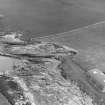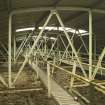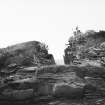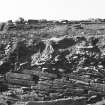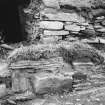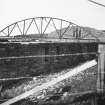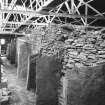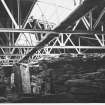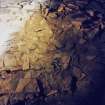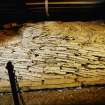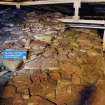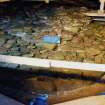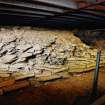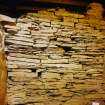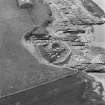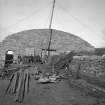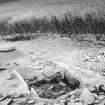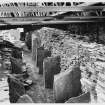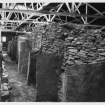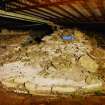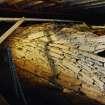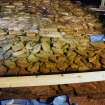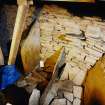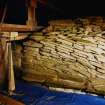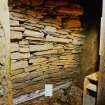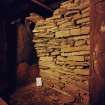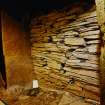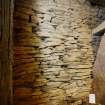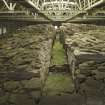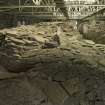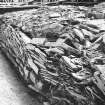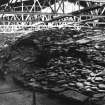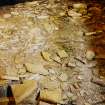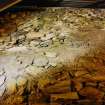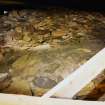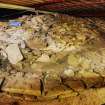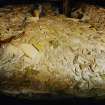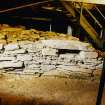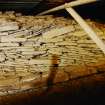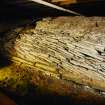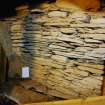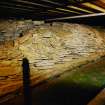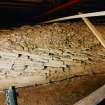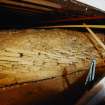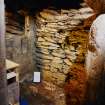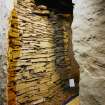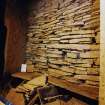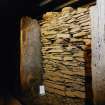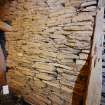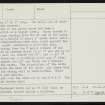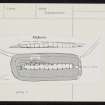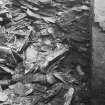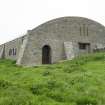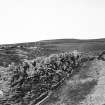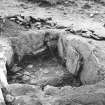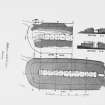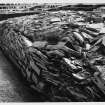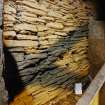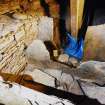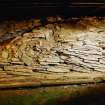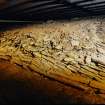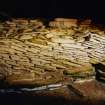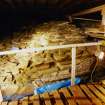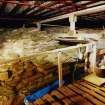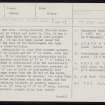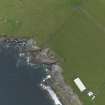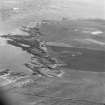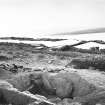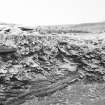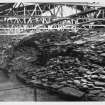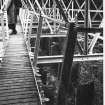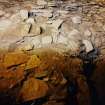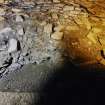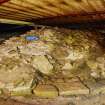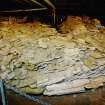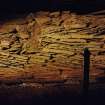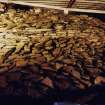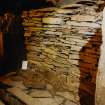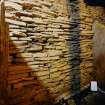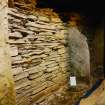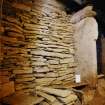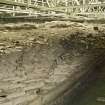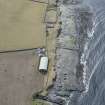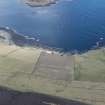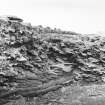Following the launch of trove.scot in February 2025 we are now planning the retiral of some of our webservices. Canmore will be switched off on 24th June 2025. Information about the closure can be found on the HES website: Retiral of HES web services | Historic Environment Scotland
Rousay, Midhowe
Chambered Cairn (Neolithic), Inhumation(S) (Neolithic) - (Early Bronze Age)
Site Name Rousay, Midhowe
Classification Chambered Cairn (Neolithic), Inhumation(S) (Neolithic) - (Early Bronze Age)
Canmore ID 2274
Site Number HY33SE 1
NGR HY 3722 3048
Datum OSGB36 - NGR
Permalink http://canmore.org.uk/site/2274
First 100 images shown. See the Collections panel (below) for a link to all digital images.
- Council Orkney Islands
- Parish Rousay And Egilsay
- Former Region Orkney Islands Area
- Former District Orkney
- Former County Orkney
HY33SE 1 3722 3048.
(HY 3719 3052) Mid Howe: Orkney-Cromarty Stalled Cairn. Before excavation in 1932-3 and later in 1934, it was a long grassy mound from which the tops of some upright stones projected. It has now been placed under the guardianship of the Dept of the Environment who have enclosed it in a stone building.
The cairn, rectangular in plan with rounded corners, measures 106' 9" in length and 42' 6" in width, with the main axis SE-NW. It is bounded by an elaborately built wall-face with another wall-face 4' 6" to 7' 9" within it. The outer wall-face is constructed with two horizontally laid foundation courses; the inner wall-face survives up to a height of 6' and is built of horizontally laid slabs. The passage opens from the SE end of the cairn. The outer end was found blocked by masonry, its outer face flush with the outer wall-face round the cairn, and the inner end was similarly blocked; no roofing remains.
The chamber is 76' long by 6' 6" to 8' wide, divided by pairs of transverse upright slabs into twelve compartments from 4' to 7' long. The walls are of well-built vertical dry masonry.
At the NW end of the cairn there had been a secondary occupation at a higher level. There seemed to have been a passage leading from the NW end of the cairn to the chamber as a height of about 3' above floor level. Some secondary constructions were also found against the N corner of the cairn, including a cist-like tank.
Two walls spring from the N and E corners of the cairn. They have an average width of 4' 6" and are up to 4' high. The N wall was traced for 68', and at 36' 6" from the cairn there was a carefully built gap 2' wide; the E wall was traced for 45' and there was a similar gap 3' 6" from the cairn. The foundations of the walls are 9" to 12" below the base of the cairn, and where they abut the cairn its facing wall is undisturbed. Their date and purpose are unknown.
Various finds from the site are in the National Museum of Antiquities of Scotland (NMAS). The pottery is of the Unstan type.
A S Henshall 1963; RCAHMS 1946; R W Feachem 1963; J G Callander 1934.
Mid How Chambered Cairn (As per HBM [DofE] plaque), at HY 3722 3048, as described and planned, housed inside a building.
Visited by OS (AA) 10 October 1972.
Field Visit (1941)
Visited by Childe in 1941.
V G Childe 1942
Note (1982)
Midhowe (ORK 37) HY 3722 3048 HY33SE 1
Site was unknown before discovery and excavation in 1932-3; the name Midhowe belongs to the nearby broch (HY33SE 2). An impressive stalled cairn in SOD guardianship. Finds in NMAS.
RCAHMS 1982
(Callander and Grant 1934a; Wilson Portfolio f. 5; RCAHMS 1946, ii, pp. 221-5, No. 583; Henshall 1963, 222-5; OR 605)
Publication Account (1996)
Built on low-lying ground near the sea, this excavated stalled cairn is entirely housed within a modern hangar-like building, so that it can be viewed both at ground-level and from an overhead walkway; it is a very fine monument, with an elongated chamber, 23m in length, divided by pairs of upright slabs into twelve compartments and encased within an oblong cairn. A decorative effect has been achieved on the outer face of the cairn by setting stones at an angle, best seen almost as a herring-bone pattern on the east face. At its northeast corners, the cairn is attached to contemporary field-walls which have been traced for about 20m and 13m respectively, underlining the association of the tomb with its surrounding agrarian landscape.
The chamber had been filled with stones when the tomb was closed (masonry closing the passage is still in position) and the contents were undisturbed: remains of twenty-five people were found, mostly lying on or tucked beneath the shelves along the east side of the chamber, including nine complete skeletons.
Information from ‘Exploring Scotland’s Heritage: Orkney’, (1996).
Note (2020)
Midhowe
This burial site in Orkney Islands was a focus for funerary practices in the Bronze Age period, between 2450 BC and 2201 BC.
Prehistoric Grave Goods project site ID: 60074
CANMORE ID: 2274
Total no. graves with grave goods: 4
Total no. people with grave goods: 8
Total no. grave goods: 8
Prehistoric Grave Goods project Grave ID: 72336
Grave type: Chamber
Burial type(s): Inhumation, Inhumation, Inhumation
Grave good: Shell
Materials used: Coral/Shell [Shell]
Current museum location: National Museum of Scotland
Prehistoric Grave Goods project Grave ID: 72337
Grave type: Chamber
Burial type(s): Inhumation, Inhumation
Grave good: Pot; Materials used: Pottery; Current museum location: National Museum of Scotland
Grave good: Pot; Materials used: Pottery; Current museum location: National Museum of Scotland
Grave good: Pot; Materials used: Pottery; Current museum location: National Museum of Scotland
Grave good: Pot; Materials used: Pottery; Current museum location: National Museum of Scotland
Prehistoric Grave Goods project Grave ID: 72338
Grave type: Chamber
Burial type(s): Inhumation, Inhumation
Grave good: Pot; Materials used: Pottery; Current museum location: National Museum of Scotland
Grave good: Pot; Materials used: Pottery; Current museum location: National Museum of Scotland
Prehistoric Grave Goods project Grave ID: 72339
Grave type: Chamber
Burial type(s): Inhumation
Grave good: Animal Bone (Other)
Materials used: Pottery
Current museum location: National Museum of Scotland
Further details, the full project database and downloads of project publications can be found here: https://doi.org/10.5284/1052206
An accessible visualisation of the database can be found here: http://blogs.reading.ac.uk/grave-goods/map/
Orkney Smr Note
No local name is preserved; the site is conventionally
referred to as Midhowe Cairn although Midhowe is really the name
of the broch OR 631.
From FIELD 23 MUSEUM LOCATION & REF:
~~~~~~~~~~~~~~~~~~~~~~~~~~~~~~~~~~~~
NMA EO 459-73. Skeletal: Anatomy Dept, Aberdeen Univ.
Animal bones. Royal Scottish Museum.
================================================================
Orkney-Cromarty stalled cairn 106ft 9in long overall, the
chamber having 12 compartments. Before excavation in 1932-3 and
1934 it was a long grassy mound from which the tops of some of
the slabs projected. Now in SDD guardianship and enclosed within
a stone building. [R1]
Information from Orkney SMR [n.d.]










































































































